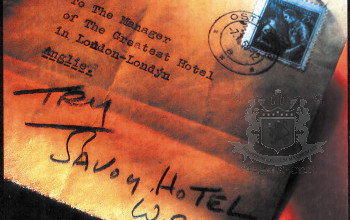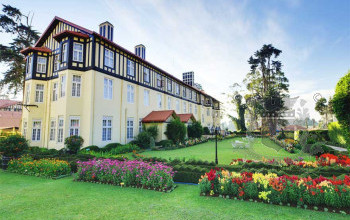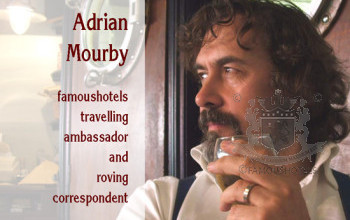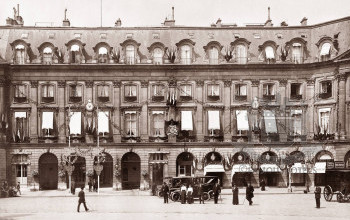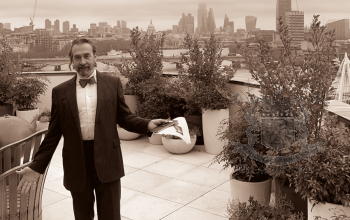The First “Grand” Hotel
( words)
250 YEARS OF GRAND HOTELS
250 YEARS OF GRAND HOTELS — In January 1774 David Low opened in London the first so called 'Grand Hotel' in the world. Others followed -- we list 70 "Grand Hotels" in our timeline
250 YEARS OF GRAND HOTELS — For the opening, in 1774, David Low invited the Duke of Bedford's chief agent to the opening. The hotel was intended for residence by a wealthy clientèle, with a top price of 15s. a night for a suite of two rooms. Best seat in church included!
In No. 43 King Street, in Covent Garden, the first house to be built on this site, was occupied by Admiral Edward Russell in 1689 or 1690. He had played a leading part in bringing William of Orange to England, and as Treasurer of the Navy and commander of the fleet was the dominant naval figure in the French war of 1689–97, defeating the French fleet at La Hogue in 1692. In May 1697 he was created Earl of Orford. Later in the same year he took a twenty-one-year lease of this house from his uncle (who by then had become the first Duke of Bedford).
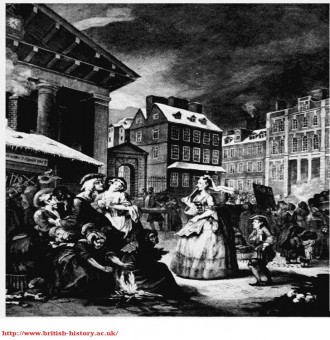
The Piazza North-west corner as depicted by Hogarath in 1738.jpeg
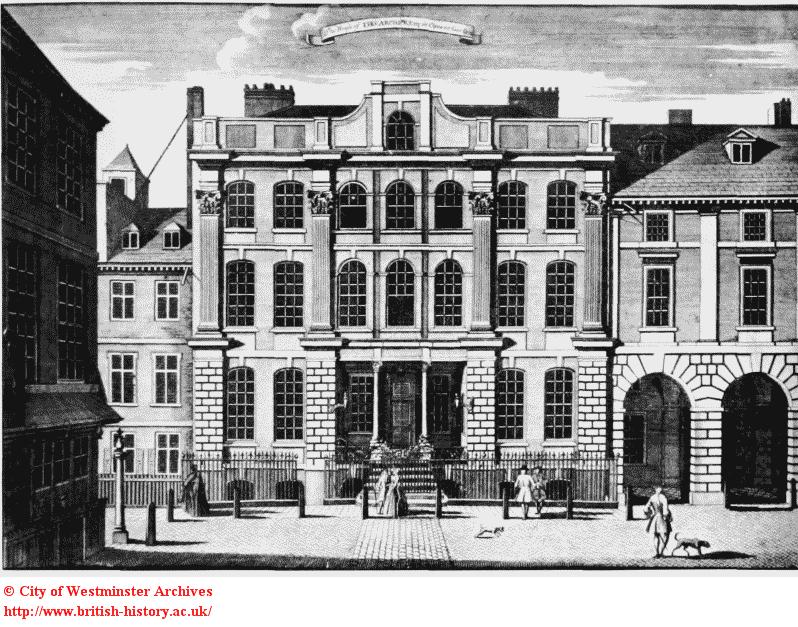
1747: 43 Kings Road, 30 years before it became a hotel,
Orford died in 1727 and we jump ahead of time to the 1770s, when the residential quarters of the seventeenth-century aristocracy were undergoing a decisive degradation, and henceforward Lord Orford's old house ceased to be a private residence. In May 1773 a fifty-five-year lease, to run from Midsummer 1779, was taken by David Low, described as a peruke-maker of Covent Garden (probably Southampton Street). The rent was £200 per annum.
In January 1774 Low opened the house as the Grand Hotel. He invited the Duke of Bedford's chief agent to the opening. The hotel was intended for residence by a wealthy clientèle, with a top price of 15s. a night for a suite of two rooms.
From an early date the occupant of the house on this site had enjoyed the use of the most prominent pew in the church, in the centre of the east gallery, over the communion table: the respectability of Low's hotel is shown by his and his successor's eagerness to obtain the continuance of this privilege for their customers.
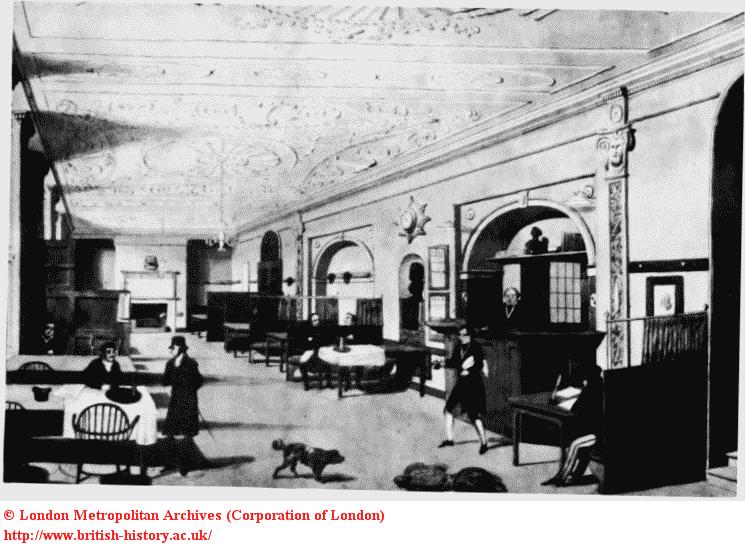
1774: the coffeeroom
By 1776 Low had added a range of bedrooms to the northern rear wing of the house, and made a coffee room in the basement. Other decorative work of this period, probably installed by Low, survived into the nineteenth century. He also made an opening into the house from the portico walk. Low later claimed that his alterations cost him £6,000 or £7,000.
He fell into difficulties with mortgagees, and by 1779 the ratepayer was another hotel-keeper, Isaac Froome, evidently as Low's lessee at a rent of £525 per annum. By 1786 Low was bankrupt and his assignees put the lease of the property up to auction, when it was bought for £1,600 by Froome. The character of the establishment is brought out in a letter to the Duke of Bedford in 1788 from Froome who sought the Duke's inspection and recommendation of 'the only Hotel for Families on your Grace's estate . . . being fitted up in a Stile of Elegance for the reception of the Nobility and Gentry requiring temporary residence in Town'.
From 1795 until the 1830's the building was usually in divided occupation, as a hotel and a coffee room. The appearance of the latter in 1804, evidently not much altered since Low's day, is shown on Plate 78b. It was at that time in the possession of Charles Richardson, who had acquired the famous lion's head originally at Button's coffee house, which can be discerned on the end wall.
In 1833 (and perhaps earlier) part of the premises was let off in apartments as Covent Garden Chambers. In the following year the lease was renewed to Walter Richardson, wine merchant, for twenty-one years at £260 per annum. In the previous year, however, some fittings, including a carved marble slab (part of a chimneypiece) and two 'landings' of inlaid oak. were removed by the Duke.
In the years 1835–7 the newly formed (Royal) Institute of British Architects had its first headquarters here, under a sub-lease at £100 per annum from Walter Richardson's mortgagee, Sir Henry Richardson.
By this time, however, part of the premises, still known as the Grand Hotel, was in the hands of a former actor and singer, W. C. Evans, who during the 1840's made the house very well known as a late-night rendezvous for song-andsupper entertainments in the basement.
Evans was succeeded in about 1846 by John Green, a self-styled 'father of the music halls'. Under 'Paddy' Green the song-and-supper part of the establishment, still retaining the name of 'Evans's', prospered greatly.
In 1850–1 some alterations of unknown extent were made to the building. In 1855 Green took a forty-year lease of the premises and had a large singing-room or music hall constructed at the back of the hotel. It was approached via the old singing-room in the basement, which had been made, probably by Evans, out of the former coffee room.
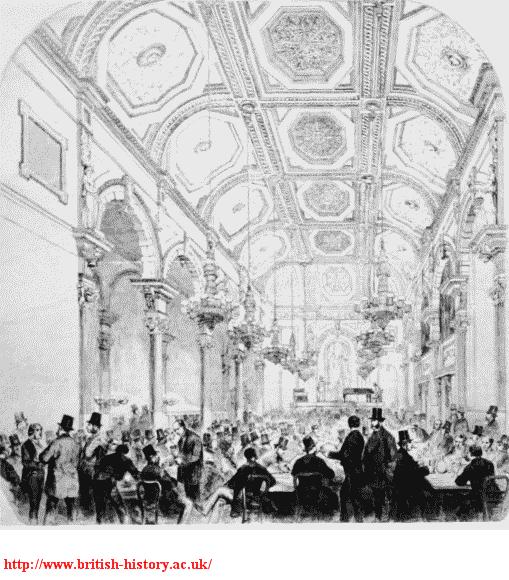
Evan's music hall at No. 43 King Street, 1855. W. Finch Hill, architect
The architect was W. Finch Hill. This expensive piece of work, with its Bath-stone columns and elaborate gas-lighting, was built in four months, to be ready to receive the provincial visitors to London 'during the week of the Cattle Show'. The contractor was W. Jackson, and the work, with some alterations to the hotel, cost nearly £7,000. (ref. 122) The appearance of the new room was applauded as a sign of improving public taste by The Builder and also by The Art Fournal, which thought it 'one of the most elegant rooms in London; its proportions are magnificent, and its style of decoration sufficiently classic, without that sombre look it too frequently assumes'. Green was also congratulated on 'having elevated the moral tone of its amusements and made them unobjectionable', a fact of which he was contentedly self-conscious. In 1871 alterations were made to the music hall and the hotel, by the architect J. H. Rowley. The former was enlarged, redecorated with much use of lookingglass, and boxes were constructed all round it. The cost was again about £7,000.
It was probably during Green's tenure, which ended about this time, that the upper part of the façade was given its present appearance, which it had certainly acquired by 1877.
In 1874 and 1875 the Savage Club occupied premises here, but the use of part of the building as a hotel seems to have continued until 1880.
Designs were prepared in 1876–7 by Henry Clutton, as the ninth Duke's consultant architect, to bring the Grand Hotel into harmony with his remodelling of the buildings in and adjacent to the Piazza, but this was not done, although the buildings on either side were designed or given elevations by Clutton. It was, however, in the years 1877–80 that the entrance to the hotel from the portico walk received its present door and doorcase. The designer is not known.
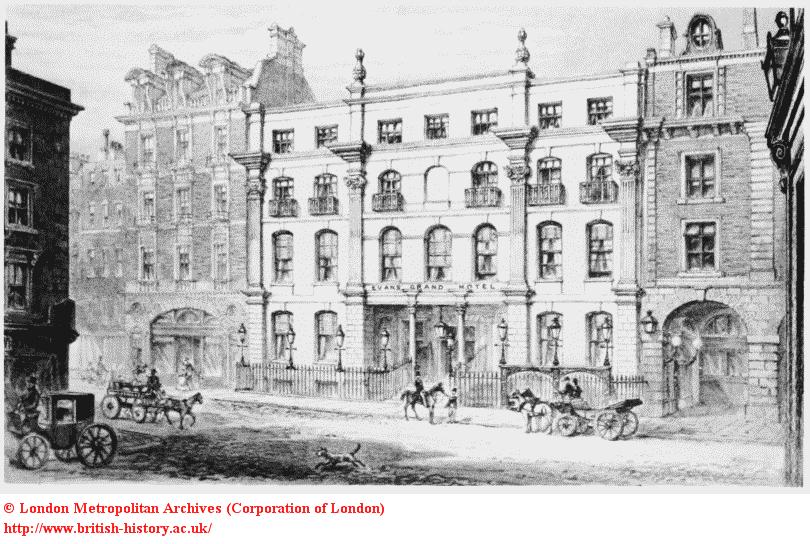
No. 43 King Street, exterior. In 1880 the first Grand Hotel in history closed*.
* In c. 1882–3 the premises were occupied by John Hollingshead's Falstaff Club, for which the upper part of the house was decorated with paintings (by Albert Calcott) and plaster reliefs illustrating The Merry Wives of Windsor.
1884—1890 this was succeeded by the New Club, run by an associate of Hollingshead's, Colonel F. A. Wellesley. The New Club enjoyed the patronage of the Prince of Wales and attracted a wealthy and aristocratic membership: both it and the Falstaff Club staged 'dances and entertainments' as well as providing the usual club facilities.
In 1891 the premises were taken by the newly founded National Sporting Club, which staged its boxing contests in the former music hall. Plans for the alteration and decoration of this boxing hall were made in 1911–12 by the architects Mewès and Davis, but it is uncertain whether they were carried out. The club remained here until its closure in 1929. The premises were then taken by the present occupants, George Monro, fruiterers, for whom extensive alterations were carried out by E. A. Shaw and Partners, architects and surveyors. They included the removal (between May 1932 and February 1934) of the original columned entrance, to provide access for lorries to the warehouse at the rear.
In 1929 there had been an intention to build a theatre on part of the site and although this was not done the third floor was hired in 1934 by the Players' Theatre Club, previously in New Compton Street. This soon closed, but in October 1936 a theatre club was re-opened on the third floor by Peter Ridgeway, as the New Players' Theatre, until its move to Albemarle Street in October 1940.
When the alterations were made for George Monro the staircase of Lord Orford's time was removed. In 1962 it was re-erected by Professor Sir Albert Richardson in South Walsham Hall, Norfolk. Today the architectural description is quite sober: 'Despite its mutilated front and altered interior, No. 43 King Street is still an important example of a town mansion.'
___________________________
Source: famoushotels.org main archives, Vienna
London Metropolitan Archives (photographs)


